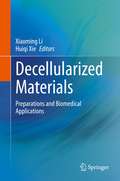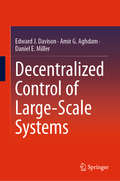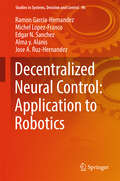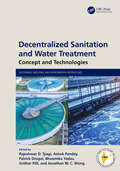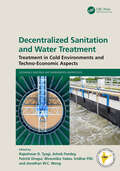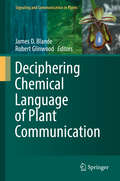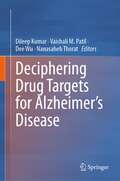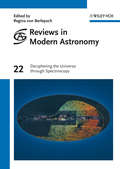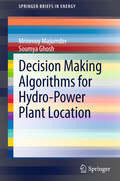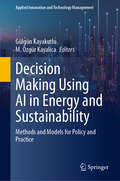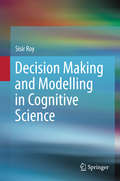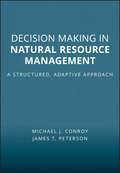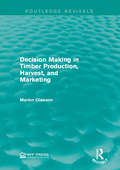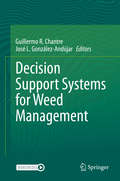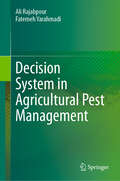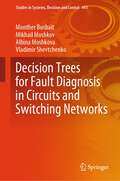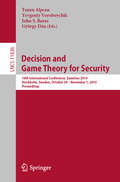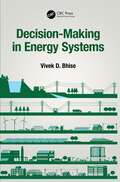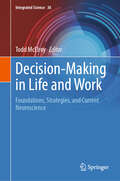- Table View
- List View
Decellularized Materials: Preparations and Biomedical Applications
by Xiaoming Li Huiqi XieThis book will consist of 8 chapters, in which important issues regarding decellularized materials (DMs) will be discussed. This book will provide special knowledge of materials for the persons with biomedical background, and special biomedical knowledge for the persons with the background of materials, which will hopefully become a valuable informative read for the researchers and students of biomedical engineering major.
Decellularized Scaffolds and Organogenesis: Methods and Protocols (Methods in Molecular Biology #1577)
by Kursad TurksenThis practical, hands-on volume examines the use of decellularized tissues and organs as biologically-active scaffolds by providing numerous approaches from experts in the field. While knowledge of how to grow and differentiate cells in culture has dramatically improved over time, the book addresses the challenges of how to instruct particular cells of interest to recognize and respond to their environment so as to proliferate, differentiate, and function for restoration of original tissue and organ form and function. Written for the highly successful Methods in Molecular Biology series, chapters include introductions to their respective topics, lists of the necessary materials and reagents, step-by-step, readily reproducible protocols, and tips on troubleshooting and avoiding known pitfalls.Authoritative and easy to use, Decellularized Scaffolds and Organogenesis: Methods and Protocols share novel approaches and insights that will provide new opportunities for those already in the field or moving to enter the field.
Decentralized Control of Large-Scale Systems
by Edward J. Davison Amir G. Aghdam Daniel E. MillerA large-scale system is composed of several interconnected subsystems. For such a system it is often desired to have some form of decentralization in the control structure, since it is typically not realistic to assume that all output measurements can be transmitted to every local control station. Problems of this kind can appear in electric power systems, communication networks, large space structures, robotic systems, economic systems, and traffic networks, to name only a few. Typical large-scale control systems have several local control stations which observe only local outputs and control only local inputs. All controllers are involved, however, in the control operation of the overall system. The focus of this book is on the efficient control of interconnected systems, and it presents systems analysis and controller synthesis techniques using a variety of methods. A systematic study of multi-input, multi-output systems is carried out and illustrative examples are given to clarify the ideas.
Decentralized Neural Control: Application to Robotics
by Ramon Garcia-Hernandez Michel Lopez-Franco Edgar N. Sanchez Alma Y. Alanis Jose A. Ruz-HernandezThis book provides a decentralized approach for the identification and control of robotics systems. It also presents recent research in decentralized neural control and includes applications to robotics. Decentralized control is free from difficulties due to complexity in design, debugging, data gathering and storage requirements, making it preferable for interconnected systems. Furthermore, as opposed to the centralized approach, it can be implemented with parallel processors. This approach deals with four decentralized control schemes, which are able to identify the robot dynamics. The training of each neural network is performed on-line using an extended Kalman filter (EKF). The first indirect decentralized control scheme applies the discrete-time block control approach, to formulate a nonlinear sliding manifold. The second direct decentralized neural control scheme is based on the backstepping technique, approximated by a high order neural network. The third control scheme applies a decentralized neural inverse optimal control for stabilization. The fourth decentralized neural inverse optimal control is designed for trajectory tracking. This comprehensive work on decentralized control of robot manipulators and mobile robots is intended for professors, students and professionals wanting to understand and apply advanced knowledge in their field of work.
Decentralized Sanitation and Water Treatment: Concept and Technologies (Sustainable Industrial and Environmental Bioprocesses)
by Ashok Pandey Patrick Drogui Bhoomika Yadav Sridhar Pilli Rajeshwar D. Tyagi Wong, Jonathan W.C.This book provides up-to-date information on the concepts and technologies in decentralized sanitation for wastewater treatment and management. It addresses the knowledge gap that exists between the understanding of centralized and decentralized wastewater treatment approaches. Decentralized Sanitation and Water Treatment: Concept and Technologies covers the sustainability principles and technologies involved, and common decentralized treatment and disposal methods. It includes topics like septage as a resource, resource recovery, anaerobic treatment of domestic sewage, and decentralized sanitation in various countries.Features Provides case studies from all around the world to explain the traditional and advanced technologies in decentralized sanitation and wastewater treatment Discusses real examples and cases from rural, urban, and peri-urban areas Focuses on interdisciplinary approaches of sustainability and circular economies Covers topics like water recycling, resource recovery, and use of sustainable energy sources Reviews common treatments and disposal methods of decentralized sanitation The book is meant for professionals and researchers working on wastewater treatment, environmental engineering, and ecology.
Decentralized Sanitation and Water Treatment: Treatment in Cold Environments and Techno-Economic Aspects (Sustainable Industrial and Environmental Bioprocesses)
by Ashok Pandey Rajeshwar D Tyagi Patrick Drogui Bhoomika Yadav Sridhar Pilli Wong, Jonathan W.C.This book discusses decentralized sanitation for wastewater treatment and management in cold environments. It addresses the knowledge gap that exists between the understanding of centralized and decentralized wastewater treatment approaches. Decentralized Sanitation and Water Treatment: Treatment in Cold Environments and Techno-Economic Aspects covers the sustainability principles, various technologies involved, decentralized treatment in cold countries, and the economic and social feasibility of decentralized sanitation. It provides solutions for the conservation of water sources and target-oriented sanitation approaches for wastewater treatment and recycling.Key Features Reviews the current status, challenges, and future perspectives of decentralized water treatments Discusses decentralized sanitation, water, and wastewater treatment in cold environments and Northern countries Focuses on interdisciplinary approaches of sustainability and circular economy Covers life cycle and environment assessment of decentralized sanitation systems Reviews the environmental, techno-economic, and social aspects of decentralized sanitation systems The book is meant for professionals and researchers working on wastewater treatment, environmental engineering, and ecology.
Deciduous Forests
by Donna LathamInvestigating the planet's biomes and examining the modern threats to each ecosystem, this interactive series challenges young readers to look at how their own actions influence the planet's health. With compare-and-contrast facts and vocabulary-building sidebars, each engaging guide reveals how environmental threats-both human and natural-affect plants and animals.Showcasing the diverse woodland of deciduous forests, this resource reveals how many of its threats come from humans. Covering topics such as deforestation, acid rain, disease, and invasive species, this engaging guide shows how, in the complicated web of life in the forest, even natural threats can be made worse by human activity.
Deciphering Chemical Language of Plant Communication
by James D. Blande Robert GlinwoodThis book provides an overviewof the intricacies of plant communication via volatile chemicals. Plantsproduce an extraordinarily vast array of chemicals, which provide communitymembers with detailed information about the producer's identity, physiology andphenology. Volatile organic chemicals, either as individual compounds or complexchemical blends, are a communication medium operating between plants and anyorganism able to detect the compounds and respond. The ecological andevolutionary origins of particular interactions between plants and the greatercommunity have been, and will continue to be, strenuously debated. However, itis clear that chemicals, and particularly volatile chemicals, constitute amedium akin to a linguistic tool. As well as possessing a rich chemicalvocabulary, plants are known to detect and respond to chemical cues. These cues can originate from neighbouring plants, or other associatedcommunity members. This book begins with chapters on the complexity of chemicalmessages, provides a broad perspective on a range of ecological interactionsmediated by volatile chemicals, and extends to cutting edge developments on thedetection of chemicals by plants.
Deciphering Drug Targets for Alzheimer’s Disease
by Dileep Kumar Nanasaheb Thorat Vaishali M. Patil Dee WuThis book explains the fundamental characteristics and biofunctionality of Alzheimer’s Disease drug targets and provides up-to-date information on the full range of their biomedical applications. An introductory section gives an overview of the recent developments related to drug targets identified and studied related to Alzheimer’s Disease and key developments from preclinical and clinical studies focusing on various molecular targets related to AD and dementia by subject experts all around the globe. Here, individual chapters address the progress and perspectives in human and non-human research, role of various biomarkers as an overview, advanced gene therapy, and novel compounds for therapeutic targets for Alzheimer’s disease. The book will be essential reading for graduate students, scientists, and engineers in any of the biomedical research fields in which efforts are being made to utilize novel drug targets and develop effective strategies for new drug targeting and delivery in Alzheimer’s disease treatment.
Deciphering the Universe through Spectroscopy (Reviews in Modern Astronomy #22)
by Regina Von BerlepschThis 22nd volume in the series contains 15 invited reviews and highlight contributions from outstanding speakers presented during the 2009 annual meeting of the Astronomical Society on the subject of "Deciphering the Universe through Spectroscopy", held in Potsdam, Germany. Topics range from the measurements of magnetic fields on the surface of the sun via detailed measurements of abundances in stellar atmospheres to the kinematics of the universe at its largest scales. The result is a systematic overview of the latest astronomical and cosmological research.
Decision Analysis Applied to the Field of Environmental Health (Professional Practice in Earth Sciences)
by Dilber Uzun Ozsahin Berna Uzun James LaMoreaux Tamer SanlidagThis book provides students and researchers with a resource that includes the current application of the multi-criteria decision theory in a variety of fields, including the environment, health care, engineering, and architecture. There are many critical parameters (criteria) that can directly or indirectly affect the consequences of various decisions. The application of the multi-criteria decision theory focusses mainly on the use of computational methods which include multiple criteria and orders of preference for the evaluation and the selection of the best option among many alternatives based on the desired outcome. The theory of multi-criteria decision making (MCDM) is an approach that can be extremely useful for students, managers, engineers of manufacturing companies, etc.
Decision Making Algorithms for Hydro-Power Plant Location
by Mrinmoy Majumder Soumya GhoshThe present study has attempted to apply the advantage of neuro-genetic algorithms for optimal decision making in maximum utilization of natural resources. Hydro-power is one of the inexpensive, but a reliable source of alternative energy which is foreseen as the possible answer to the present crisis in the energy sector. However, the major problem related to hydro-energy is its dependency on location. An ideal location can produce maximum energy with minimum loss. Besides, such power-plant also requires substantial amount of land which is a precious resource nowadays due to the rapid and uncontrolled urbanization observed in most of the urban centres in the World. The feasibility of such plants also depends on social acceptance as well as the level of environmental casualty and economic benefit, all of which is also spatially dependent. Decision making algorithms are applied to identify better solution if a problem has more than one alternative explication. Nature based algorithms are found to be efficient enough to catalyze such kind of decision making analysis. That is why the present study tries to utilize nature based algorithms to solve the problems of location selection for hydropower plants. The study employed six different types of nature based algorithms to select one of the locations among many available for installation of hydropower plant in the North Eastern part of the Indian subcontinent. The locations are selected based on their in stream resources and included in the decision making as alternatives. A methodology of criteria selection, determination of weightage and applications of bioinspired algorithms are adopted to produce utmost exertion of the available natural resources with minimum hostility and wastage of the same.
Decision Making Using AI in Energy and Sustainability: Methods and Models for Policy and Practice (Applied Innovation and Technology Management)
by Gülgün Kayakutlu M. Özgür KayalicaArtificial intelligence (AI) has a huge impact on science and technology, including energy, where access to resources has been a source of geopolitical conflicts. AI can predict the demand and supply of renewable energy, optimize efficiency in energy systems, and improve the management of natural energy resources, among other things. This book explores the use of AI tools for improving the management of energy systems and providing sustainability with smart cities, smart facilities, smart buildings, smart transportation, and smart houses. Featuring research from International Federation for Information Processing's (IFIP) “AI in Energy and Sustainability” working group, this book provides new models and algorithms for AI applications in energy and sustainability fields. Any short-term, mid-term and long-term forecasting, optimization models, trend foresights and prescriptions based on scenarios are studied in the energy world and the smart systems for sustainability. The contents of this book are valuable for energy researchers, academics, scholars, practitioners and policy makers.
Decision Making and Modelling in Cognitive Science
by Sisir RoyThis book discusses the paradigm of quantum ontology as an appropriate model for measuring cognitive processes. It clearly shows the inadequacy of the application of classical probability theory in modelling the human cognitive domain. The chapters investigate the context dependence and neuronal basis of cognition in a coherent manner. According to this framework, epistemological issues related to decision making and state of mind are seen to be similar to issues related to equanimity and neutral mind, as discussed in Buddhist perspective. The author states that quantum ontology as a modelling tool will help scientists create new methodologies of modelling in other streams of science as well.
Decision Making for the Environment: Social and Behavioral Science Research Priorities
by National Research Council of the National AcademiesWith the growing number, complexity, and importance of environmental problems come demands to include a full range of intellectual disciplines and scholarly traditions to help define and eventually manage such problems more effectively. Decision Making for the Environment: Social and Behavioral Science Research Prioritiesis the result of a 2-year effort by 12 social and behavioral scientists, scholars, and practitioners. The report sets research priorities for the social and behavioral sciences as they relate to several different kinds of environmental problems.
Decision Making in Natural Resource Management: A Structured, Adaptive Approach
by Michael J. Conroy James T. PetersonThis book is intended for use by natural resource managers and scientists, and students in the fields of natural resource management, ecology, and conservation biology, who are confronted with complex and difficult decision making problems. The book takes readers through the process of developing a structured approach to decision making, by firstly deconstructing decisions into component parts, which are each fully analyzed and then reassembled to form a working decision model. The book integrates common-sense ideas about problem definitions, such as the need for decisions to be driven by explicit objectives, with sophisticated approaches for modeling decision influence and incorporating feedback from monitoring programs into decision making via adaptive management. Numerous worked examples are provided for illustration, along with detailed case studies illustrating the authors’ experience in applying structured approaches. There is also a series of detailed technical appendices. An accompanying website provides computer code and data used in the worked examples. Additional resources for this book can be found at: www.wiley.com/go/conroy/naturalresourcemanagement.
Decision Making in Timber Production, Harvest, and Marketing (Routledge Revivals)
by Marion ClawsonClawson explores the issues related to timber management with a particular focus on the harvesting of timber stands in Decision Making in Timber Production, Harvest and Marketing. Originally published in 1977, her study considers biological, economic and management implications of timber growing as well as the decision-making process in U.S forest Situations including methods of analysis. This title will be of interest to students of Environmental studies and professionals.
Decision Science for Future Earth: Theory and Practice
by Tetsukazu YaharaThis open access book provides a theoretical framework and case studies on decision science for regional sustainability by integrating the natural and social sciences. The cases discussed include solution-oriented transdisciplinary studies on the environment, disasters, health, governance and human cooperation. Based on these case studies and comprehensive reviews of relevant works, including lessons learned from past failures for predictable surprises and successes in adaptive co-management, the book provides the reader with new perspectives on how we can co-design collaborative projects with various conflicts of interest and how we can transform our society for a sustainable future. The book makes a valuable contribution to the global research initiative Future Earth, promoting transdisciplinary studies to bridge the gap between science and society in knowledge generation processes and supporting efforts to achieve the UN’s Sustainable Development Goals (SDGs). Compared to other publications on transdisciplinary studies, this book is unique in that evolutionary biology is used as an integrator for various areas related to human decision-making, and approaches social changes as processes of adaptive learning and evolution. Given its scope, the book is highly recommended to all readers seeking an integrated overview of human decision-making in the context of social transformation.
Decision Support Systems for Weed Management
by Guillermo R. Chantre José L. González-AndújarWeed management Decision Support Systems (DSS) are increasingly important computer-based tools for modern agriculture. Nowadays, extensive agriculture has become highly dependent on external inputs and both economic costs, as well the negative environmental impact of agricultural activities, demands knowledge-based technology for the optimization and protection of non-renewable resources. In this context, weed management strategies should aim to maximize economic profit by preserving and enhancing agricultural systems. Although previous contributions focusing on weed biology and weed management provide valuable insight on many aspects of weed species ecology and practical guides for weed control, no attempts have been made to highlight the forthcoming importance of DSS in weed management. This book is a first attempt to integrate `concepts and practice’ providing a novel guide to the state-of-art of DSS and the future prospects which hopefully would be of interest to higher-level students, academics and professionals in related areas.
Decision System in Agricultural Pest Management
by Ali Rajabpour Fatemeh YarahmadiThis book covers the theoretical and practical aspects of pest population components, explaining the probable reasons for pest density fluctuations and outbreaks in agricultural or other ecosystems. Agricultural pest management is a complex task that involves dealing with a variety of pests, including insects, diseases, and weeds. Decision systems can help farmers navigate this complexity by providing structured approaches to identify, monitor, and control pests. By making informed decisions based on data and models, farmers can reduce unnecessary pesticide applications, minimizing environmental impact and saving costs. This book aids in predicting pest outbreaks using population growth parameters and estimating economic crop losses through critical thresholds, illustrated with simple case studies. Additionally, the book covers image processing, remote sensing monitoring, and other novel methods for monitoring and quickly forecasting pest population outbreaks to developintegrated pest management (IPM) programs. The book is valuable for agricultural and entomological students (graduates and postgraduates), researchers, as well as pest managers and farmers.
Decision Trees for Fault Diagnosis in Circuits and Switching Networks (Studies in Systems, Decision and Control #493)
by Mikhail Moshkov Monther Busbait Albina Moshkova Vladimir ShevtchenkoIn this book, we study decision trees for fault diagnosis in circuits and switching networks, which are among the most fundamental models for computing Boolean functions. We consider two main cases: when the scheme (circuit or switching network) has the same mode of operation for both calculation and diagnostics, and when the scheme has two modes of operation—normal for calculation and special for diagnostics. In the former case, we get mostly negative results, including superpolynomial lower bounds on the minimum depth of diagnostic decision trees depending on scheme complexity and the NP-hardness of construction diagnostic decision trees. In the latter case, we describe classes of schemes and types of faults for which decision trees can be effectively used to diagnose schemes, when they are transformed into so-called iteration-free schemes. The tools and results discussed in this book help to understand both the possibilities and challenges of using decision trees to diagnose faults in various schemes. The book is useful to specialists both in the field of theoretical and technical diagnostics.It can also be used for the creation of courses for graduate students.
Decision and Game Theory for Security: 10th International Conference, GameSec 2019, Stockholm, Sweden, October 30 – November 1, 2019, Proceedings (Lecture Notes in Computer Science #11836)
by Tansu Alpcan Yevgeniy Vorobeychik John S. Baras György DánThis book constitutes the refereed proceedings of the 10th International Conference on Decision and Game Theory for Security, GameSec 2019,held in Stockholm, Sweden, in October 2019.The 21 full papers presented together with 11 short papers were carefully reviewed and selected from 47 submissions.The papers focus on protection of heterogeneous, large-scale and dynamic cyber-physical systems as well as managing security risks faced by critical infrastructures through rigorous and practically-relevant analytical methods.
Decision-Making in Energy Systems
by Vivek D. BhiseThis is a comprehensive book on how to make complex decisions on energy systems problems involving different technologies, environmental effects, costs, benefits, risks, and safety issues. Using Industrial and Systems Engineering techniques for decision-making in Energy Systems, the book provides the background knowledge and methods to incorporate multiple criteria involved in solving energy system problems. It offers methods, examples, and case studies illustrating applications. Decision-Making in Energy Systems discusses subjective as well as objective methods, approaches, and techniques taken from the systems and industrial engineering domain and puts them to use in solving energy systems problems. It uses an integrated approach by including effects of all technical, economic, environmental, and safety considerations as well as costs and risks. The book is specially designed for practicing engineers from industrial/systems engineering who work in energy systems engineering industries. Aimed at graduate students, researchers, and managers involved in various energy generating, distributing, and consuming companies, the book helps the reader to understand, evaluate, and decide on solutions to their energy-related problems.
Decision-Making in Environmental Health: From Evidence to Action
by D. Briggs C. Corvalan G. ZielhuisDecision-Making in Environmental Health examines the need for information in support of decision-making in environmental health. It discusses indicators of environmental health, methods of data collection and the assessment of exposure to and the health impact of different environmental risk factors.
Decision-Making in Life and Work: Foundations, Strategies, and Current Neuroscience (Integrated Science #36)
by Todd McElroyThis groundbreaking volume brings together leading researchers to explore the latest findings on the psychological and physiological factors that shape decision-making. It offers a uniquely multidisciplinary perspective, integrating insights from neuroscience, economics, public policy, and other fields to provide a comprehensive understanding of how we make choices in both personal and professional contexts. Designed for researchers, professionals, instructors, and students interested in decision science, this book delves into several key areas. It explores the cognitive biases and heuristics that influence our decisions. The book also examines the role of emotions and intuition in decision-making. Additionally, it investigates the neuroscience behind information processing and judgment. It also provides strategies we can use to make better decisions in real-world settings. The chapters, written by experts in the field, cover a wide range of topics ranging from the foundations of decision theory to the latest research on the neural bases of decision-making, providing readers with a rich understanding of the subject. Through its multidisciplinary approach and emphasis on practical applications, this volume offers readers valuable insights and tools for enhancing their own decision-making skills. Whether you are a researcher studying decision-making processes, a professional looking to make better judgments in important situations, or an instructor teaching decision science, this book provides a comprehensive and accessible resource that will deepen your understanding of this critical area of human behavior.
